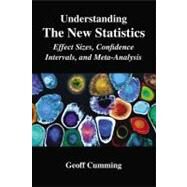- ISBN: 9780415879682 | 041587968X
- Cover: Nonspecific Binding
- Copyright: 7/14/2011
This is the first book to provide readers with an introductory yet deep understanding of the new statistics in behavioral sciences-- effect sizes (ESs), confidence intervals (CIs), and meta-analysis (MA). Practical in nature, the book provides examples and tips on how to use the new statistics to analyse and report research results and/or to understand journal articles that reference the new statistics.The author employs statistical cognition techniques to help demonstrate how researchers think about, summarize, present, and interpret data. Accompanied by a website with corresponding ESCI software and video clips (to be provided by the author), this package provides additional tools for students and researchers wishing to learn more about these new techniques.Practical tips such as how to report and interpret confidence intervals to meet the new APA Manualguidelines and which ESCI tool is most effective for calculating various measures and designs are sprinkled throughout. The book concludes with a quick and easy overview of ways to calculate CIs for various measures and/or graph CIs for a number of basic designs. The Appendix includes tips on using ESCI. Commentary on some of the exercises is provided at the end of the text. The book#xE2;#xAC;"s pedagogical program, built on cognitive science principles, reinforces learning: Boxes provide "evidence-based" tips on the most effective techniques while others summarize arguments made in the research literature to support the use of the new statistics. The book employs the use of the 3 Rs (read, recite, and review) and frequently revisits key concepts, including some exercises that call for the use of concepts and techniques introduced in earlier chapters, to strengthen understanding of the material. Numerous worked examples and problem-solving exercises are integrated within the body of the text to reinforce learning on an ongoing basis. Graphs are accompanied by detailed descriptions to help strengthen the readers visual understanding of the material Opening overviews and end of chapter take-home messages summarize the key points. Supported by Exploratory Software for Confidence Intervals (ESCI) which runs using Microsoft Excel, the book#xE2;#xAC;"s ESCI excercises allow readers to work with simulations to strengthen their understanding of the material and to use ESCI to analyse their own data sets for confidence interval calculations. ESCI provides demos and describes and graphs the symbols and values to reinforce learning. The porgram allows users to instantly see how changing some parameters impacts and changes other factors. ESCI is cross-referenced to the text so as to provide interactive simulations that illustrate the key concepts introduced in the book. ESCI tools also allow users to analyze, report, and interpret simple data#xE2;#xAC;#x1D;either their own or the data presented in the book . Chapter 21 provides a guide to using ESCI for simple CI calculations and for preparing figures. Intended as a supplementary text for graduate and/or advanced undergraduate courses in statistics and research methods and design taught in departments of psychology, education, human development , nursing, and natural, social, and life sciences, researchers and practioners interested in gaining a better understanding of the new statistics will also appreciate this book. A basic familiarity with introductory statistics is assumed. The book should be advertised to the APA#xE2;#xAC;#xDC;s Division 5, AERA Division D, and the Consortium for the Advancement of Undergraduate Statistics Education; http://www.causeweb.org/.







